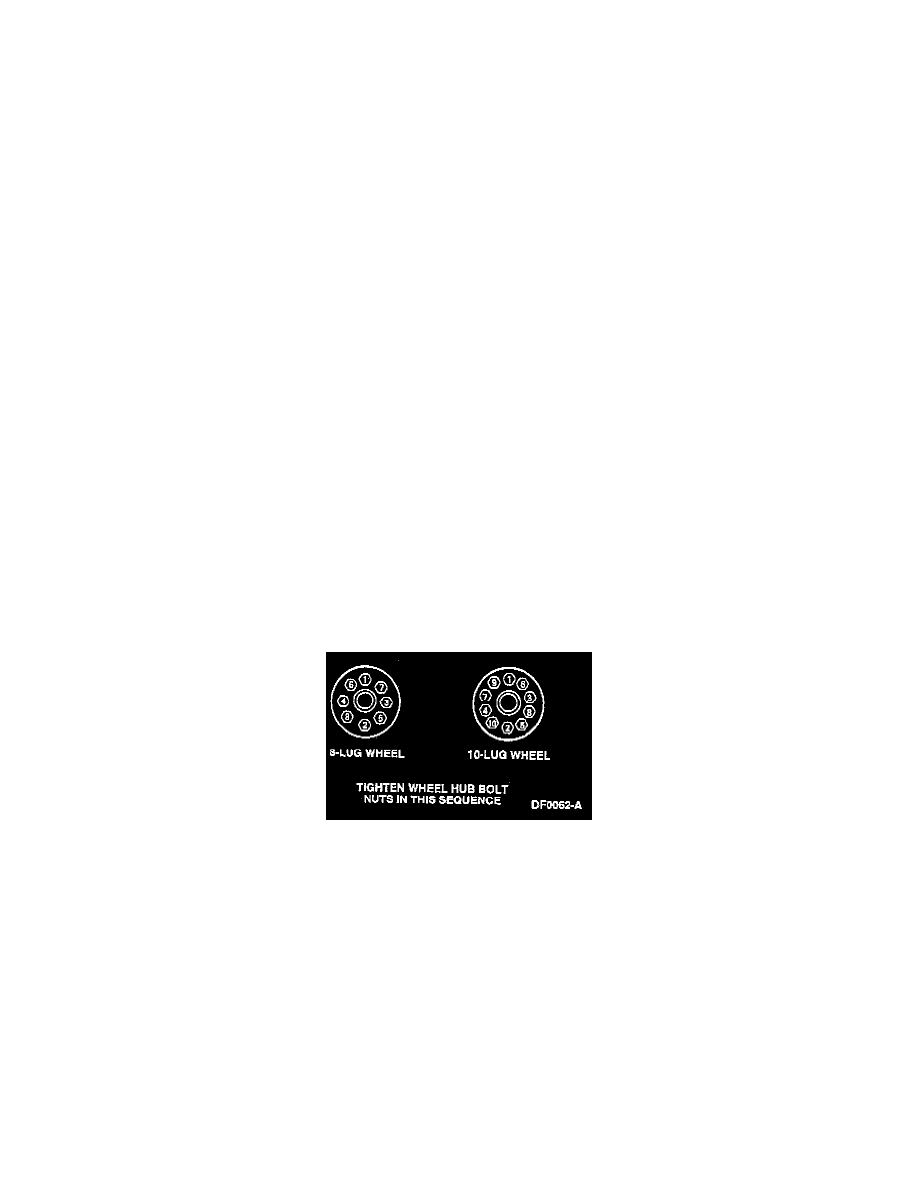F 350 4WD Pickup V8-351 5.8L VIN H EFI (1997)

Wheels: Service and Repair
Replacement
Front
REMOVAL
1. Set parking brake and block diagonally opposite wheel. On vehicles equipped with an automatic transmission, place selector lever in the PARK
position. On vehicles equipped with a manual transmission, place the shift lever in reverse. On 4-wheel drive vehicles, the transfer case must be
engaged in gear, not neutral.
WARNING:
^
AFTERMARKET WHEEL ASSEMBLIES MAY NOT BE COMPATIBLE WITH THE VEHICLE. USE OF INCOMPATIBLE
WHEEL ASSEMBLIES MAY RESULT IN EQUIPMENT FAILURE AND POSSIBLE INJURY. USE ONLY APPROVED
WHEEL ASSEMBLIES.
^
NEVER RUN THE ENGINE WITH ONE WHEEL OFF THE GROUND, FOR INSTANCE, WHEN CHANGING A TIRE. THE
WHEEL STILL ON THE GROUND COULD CAUSE THE VEHICLE TO MOVE.
2. If so equipped, remove the wheel cover.
3. With the weight of the vehicle still on the tires, loosen the lug nuts. Do not remove at this time.
4. Raise the vehicle until the wheel and tire assembly clears the floor.
5. Remove the lug nuts. Remove the wheel and tire assembly.
INSTALLATION
1. Position the wheel on the front disc brake hub and rotor.
WARNING: WHEN A WHEEL IS INSTALLED, ALWAYS REMOVE ANY CORROSION, DIRT OR FOREIGN MATERIAL
PRESENT ON THE MOUNTING SURFACES OF THE WHEEL OR THE SURFACE OF THE WHEEL HUB, BRAKE DRUM OR
BRAKE ROTOR THAT CONTACTS THE WHEEL. INSTALLING WHEELS WITHOUT PROPER METAL-TO-METAL CONTACT
AT THE WHEEL MOUNTING SURFACES CAN CAUSE THE LUG NUTS TO LOOSEN AND THE WHEEL TO COME OFF
WHILE THE VEHICLE IS IN MOTION, CAUSING LOSS OF CONTROL.
2. Install the lug nuts. Make sure the cone ends of the lug nut face inward.
3. With the lug nuts loosely installed, turn the wheel until one lug nut is at the top of the wheel hub bolt circle. Tighten the lug nut until snug. In a
crisscross type pattern, tighten the remaining lug nuts until snug to minimize runout.
4. Lower the vehicle.
5. Evenly tighten the lug nuts in the torque sequence shown in the illustration. Tighten lug nuts to 170-230 Nm (126-170 ft. lbs.).
Rear
WARNING:
^
AFTERMARKET WHEEL ASSEMBLIES MIGHT NOT BE COMPATIBLE WITH THE VEHICLE. USE OF INCOMPATIBLE
WHEEL ASSEMBLIES MIGHT RESULT IN EQUIPMENT FAILURE AND POSSIBLE INJURY. USE ONLY APPROVED WHEEL
ASSEMBLIES.
^
USE ONLY INTEGRAL TWO-PIECE SWIVELING LUG NUTS ON VEHICLES EQUIPPED WITH DUAL REAR WHEELS. DO
NOT ATTEMPT TO USE CONE-SHAPED ONE-PIECE LUG NUTS ON THESE VEHICLES. IF USED, CONE-SHAPED ONE-PIECE
LUG NUTS CAN COME LOOSE IN VEHICLE OPERATION. DO NOT ATTEMPT TO USE PAST MODEL WHEELS, WHICH
HAVE CONE-SHAPED WHEEL HUB BOLT NUT SEATS, ON THIS VEHICLE. DO NOT ATTEMPT TO USE PRESENT DESIGN
WHEELS AND LUG NUTS ON PAST MODEL WHEEL HUBS. ATTEMPTED USE OF INTERMIXED WHEELS CAN LEAD TO
DAMAGE TO THE WHEEL MOUNTING SYSTEM AND COULD RESULT IN WHEELS COMING LOOSE.
REMOVAL
1. Set parking brake and block diagonally opposite wheel.
^
On vehicles equipped with an automatic transmission, place selector lever in the PARK position.
^
On vehicles equipped with a manual transmission, place the shift lever in reverse.
